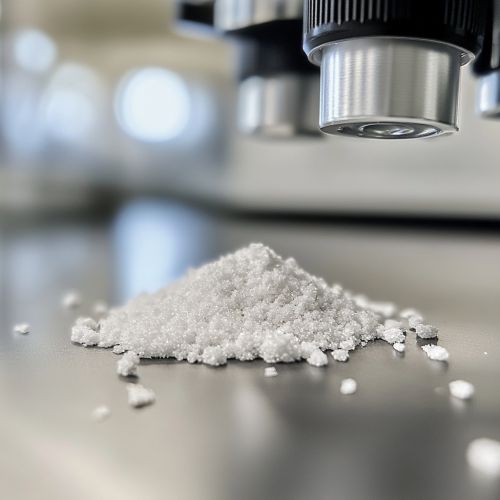Kurtz-Perry powder technique: Difference between revisions
(Created page with "== Introduction == The Kurtz-Perry powder technique is a specialized method used in materials science and solid-state chemistry for the synthesis and characterization of crystalline materials. This technique, named after its developers, is particularly valuable for its ability to facilitate the study of nonlinear optical properties in crystalline substances. By employing this method, researchers can gain insights into the intrinsic properties of materials that are cruci...") |
No edit summary |
||
| Line 19: | Line 19: | ||
The preparation of powdered samples is a critical step in the Kurtz-Perry powder technique. The material of interest is ground into a fine powder, typically with particle sizes ranging from a few micrometers to tens of micrometers. This powder is then pressed into a pellet or spread as a thin layer on a substrate. The uniformity and particle size distribution of the powder are crucial factors that influence the accuracy and reproducibility of SHG measurements. | The preparation of powdered samples is a critical step in the Kurtz-Perry powder technique. The material of interest is ground into a fine powder, typically with particle sizes ranging from a few micrometers to tens of micrometers. This powder is then pressed into a pellet or spread as a thin layer on a substrate. The uniformity and particle size distribution of the powder are crucial factors that influence the accuracy and reproducibility of SHG measurements. | ||
[[Image:Detail-104459.jpg|thumb|center|Close-up of a crystalline powder sample on a laboratory bench.|class=only_on_mobile]] | |||
[[Image:Detail-104460.jpg|thumb|center|Close-up of a crystalline powder sample on a laboratory bench.|class=only_on_desktop]] | |||
== Experimental Setup == | == Experimental Setup == | ||
Latest revision as of 10:53, 22 November 2024
Introduction
The Kurtz-Perry powder technique is a specialized method used in materials science and solid-state chemistry for the synthesis and characterization of crystalline materials. This technique, named after its developers, is particularly valuable for its ability to facilitate the study of nonlinear optical properties in crystalline substances. By employing this method, researchers can gain insights into the intrinsic properties of materials that are crucial for applications in photonics and optoelectronics.
Historical Background
The development of the Kurtz-Perry powder technique traces back to the mid-20th century, a period marked by significant advancements in the field of materials science. The technique was introduced by Dr. Stephen Kurtz and Dr. Theodore Perry, who were pioneers in the study of nonlinear optics. Their work laid the foundation for the systematic investigation of second harmonic generation (SHG) in powdered crystalline samples, a process that is central to the technique.
Principles of the Kurtz-Perry Powder Technique
The Kurtz-Perry powder technique is grounded in the principles of nonlinear optics, particularly the phenomenon of second harmonic generation. SHG is a nonlinear optical process in which two photons with the same frequency interact with a nonlinear material, resulting in the emission of a new photon with twice the frequency (and half the wavelength) of the original photons. This process is sensitive to the symmetry properties of the crystal lattice, making it a powerful tool for probing the structural characteristics of materials.
Nonlinear Optical Properties
Nonlinear optical properties are essential for understanding the behavior of materials under intense electromagnetic fields. These properties are characterized by the material's response to high-intensity light, which can lead to phenomena such as frequency doubling, self-focusing, and optical Kerr effects. The Kurtz-Perry powder technique is specifically designed to measure the efficiency of SHG in powdered samples, providing a quantitative assessment of a material's nonlinear optical coefficients.
Powdered Sample Preparation
The preparation of powdered samples is a critical step in the Kurtz-Perry powder technique. The material of interest is ground into a fine powder, typically with particle sizes ranging from a few micrometers to tens of micrometers. This powder is then pressed into a pellet or spread as a thin layer on a substrate. The uniformity and particle size distribution of the powder are crucial factors that influence the accuracy and reproducibility of SHG measurements.


Experimental Setup
The experimental setup for the Kurtz-Perry powder technique involves several key components, including a laser source, optical filters, and detectors. A laser beam, typically in the visible or near-infrared range, is directed onto the powdered sample. The interaction of the laser light with the sample generates second harmonic signals, which are detected and analyzed to determine the material's nonlinear optical properties.
Laser Source
The choice of laser source is critical for the success of the Kurtz-Perry powder technique. Commonly used lasers include Nd:YAG lasers, which emit light at a wavelength of 1064 nm, and frequency-doubled Nd:YAG lasers, which provide light at 532 nm. The laser's power and beam quality must be carefully controlled to ensure accurate SHG measurements.
Optical Filters and Detectors
Optical filters are used to isolate the second harmonic signal from the fundamental laser frequency. These filters are typically narrowband, allowing only the desired wavelength to pass through while blocking other wavelengths. Detectors, such as photomultiplier tubes or photodiodes, are employed to measure the intensity of the second harmonic signal. The sensitivity and dynamic range of the detectors are important factors that affect the precision of the measurements.
Applications of the Kurtz-Perry Powder Technique
The Kurtz-Perry powder technique has a wide range of applications in materials science and engineering. It is particularly valuable for the development of new materials with enhanced nonlinear optical properties, which are essential for advanced photonic devices.
Photonic and Optoelectronic Devices
Materials with strong nonlinear optical properties are crucial for the development of photonic and optoelectronic devices, such as frequency converters, optical modulators, and laser sources. The Kurtz-Perry powder technique enables researchers to screen and identify materials with high SHG efficiency, accelerating the discovery of new compounds for these applications.
Crystallography and Material Characterization
Beyond its applications in nonlinear optics, the Kurtz-Perry powder technique is also a valuable tool for crystallography and material characterization. By analyzing the SHG response of powdered samples, researchers can infer information about the crystal symmetry and phase transitions of materials. This information is critical for understanding the fundamental properties of crystalline substances and optimizing their performance in various applications.
Limitations and Challenges
Despite its advantages, the Kurtz-Perry powder technique has certain limitations and challenges that must be addressed. One of the primary challenges is the accurate interpretation of SHG signals from powdered samples, which can be influenced by factors such as particle size distribution, packing density, and surface roughness.
Particle Size and Morphology
The particle size and morphology of the powdered sample can significantly affect the SHG measurements. Non-uniform particle sizes can lead to scattering and diffraction effects, complicating the interpretation of the results. Additionally, the morphology of the particles, such as their shape and surface texture, can influence the interaction of light with the sample.
Sample Preparation and Reproducibility
The preparation of powdered samples requires careful attention to detail to ensure reproducibility of the results. Variations in sample preparation, such as differences in grinding techniques or pressing conditions, can lead to inconsistencies in SHG measurements. Standardizing the sample preparation process is essential for obtaining reliable and comparable data.
Future Directions
The Kurtz-Perry powder technique continues to evolve, with ongoing research focused on improving its accuracy and expanding its applications. Advances in laser technology, detector sensitivity, and data analysis methods are expected to enhance the capabilities of this technique, enabling more precise and comprehensive studies of nonlinear optical materials.
Integration with Computational Methods
The integration of the Kurtz-Perry powder technique with computational methods, such as density functional theory (DFT) and molecular dynamics simulations, offers new opportunities for the study of nonlinear optical materials. These computational approaches can provide insights into the electronic structure and optical properties of materials, complementing experimental measurements and guiding the design of new compounds.
Exploration of Novel Materials
The search for novel materials with exceptional nonlinear optical properties remains a key focus of research in this field. The Kurtz-Perry powder technique is instrumental in screening and characterizing new materials, including organic crystals, metal-organic frameworks, and hybrid perovskites. These materials hold promise for a wide range of applications, from telecommunications to quantum computing.
Conclusion
The Kurtz-Perry powder technique is a powerful and versatile tool for the study of nonlinear optical properties in crystalline materials. Its ability to provide insights into the structural and electronic characteristics of materials makes it invaluable for the development of advanced photonic and optoelectronic devices. Despite its challenges, ongoing advancements in this technique continue to expand its applications and enhance our understanding of nonlinear optical phenomena.
